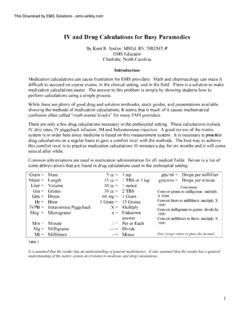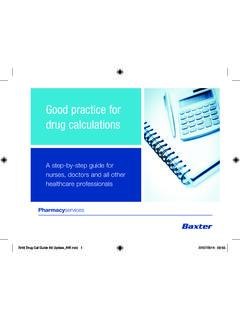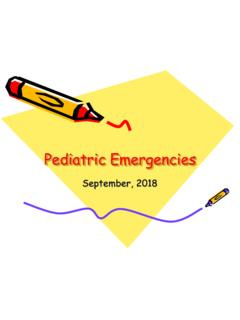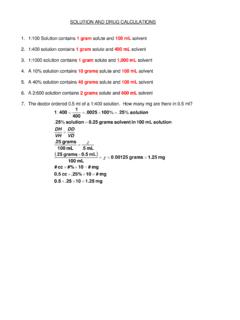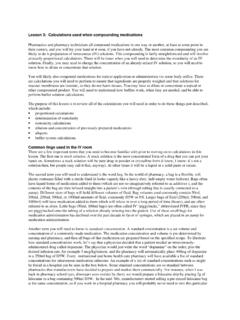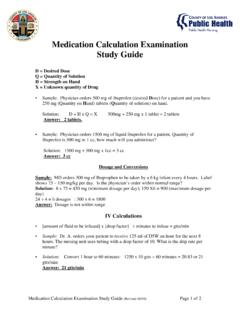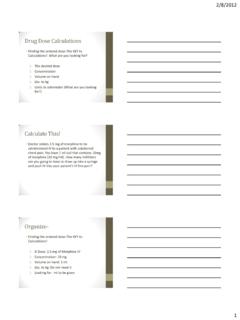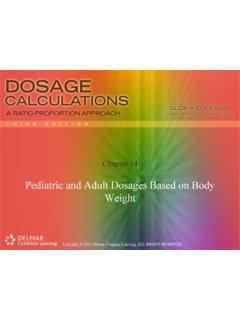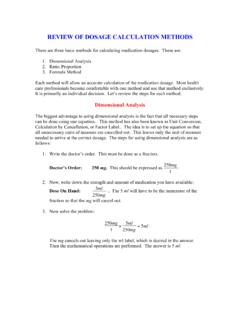Transcription of Third Edition DRUG CALCULATIONS FOR NURSES
1 DRUGCALCULATIONSFOR NURSEST hird EditionA STEP-BY-STEP APPROACHThis page intentionally left blank DRUGCALCULATIONSFOR NURSESROBERT LAPHAMBP harm Clin Dip Pharm MRPharmSClinical Pharmacist, Sunderland Royal Hospital, CityHospitals Sunderland NHS Trust, UKHEATHER AGAR RGN BSC(HONS)Rheumatology Specialist nurse , Northumbria HealthcareNHS Trust, UKThird EditionASTEP-BY-STEP APPROACHF irst published in Great Britain in 1995 by ArnoldSecond Edition 2003 This Third Edition published in 2009 byHodder Arnold, an imprint of Hodder Education,an Hachette UK company, 338 Euston Road, London NW1 3 2009 Robert Lapham and Heather AgarAll rights reserved. Apart from any use permitted under UK copyright law, this publicationmay only be reproduced, stored or transmitted, in any form, or by any means with priorpermission in writing of the publishers or in the case of reprographic production inaccordance with the terms of licences issued by the Copyright Licensing Agency.
2 In theUnited Kingdom such licences are issued by the Copyright Licensing Agency: SaffronHouse, 6 10 Kirby Street, London EC1N 8 TSHachette UK s policy is to use papers that are natural, renewable and recyclable productsand made from wood grown in sustainable forests. The logging and manufacturing processesare expected to conform to the environmental regulations of the country of the advice and information in this book are believed to be true and accurate at thedate of going to press, neither the authors nor the publisher can accept any legalresponsibility or liability for any errors or omissions that may be made. In particular (butwithout limiting the generality of the preceding disclaimer) every effort has been made tocheck drug dosages; however it is still possible that errors have been missed.
3 Furthermore,dosage schedules are constantly being revised and new adverse effects recognized. Forthese reasons the reader is strongly urged to consult the drug companies printedinstructions before administering any of the drugs recommended in this Library Cataloguing in Publication DataA catalogue record for this book is available from the British of Congress Cataloging-in-Publication DataA catalog record for this book is available from the Library of 0340 98733912345678910 Commissioning Editor:Naomi WilkinsonProject Editor:Joanna SilmanProduction Controller:Rachel ManguelCover Designer:Laura DeGrasseIndexer:Jan RossTypeset in 11pt Berling by Pantek Arts Ltd, Maidstone, and bound in do you think about this book? Or any other Hodder Arnold title?Please visit our website: is in everything, and no thing is without poison.
4 The dosage makesit either a poison or a (1493 1541)Medieval physician and alchemistContentsPrefacexHow to use this bookxiPre-testxiiBasicsxiiPer cent and percentagesxivUnits and equivalencesxivDrug strengths or concentrationsxivDosage calculationsxvMoles and millimolesxviInfusion rate calculationsxviAnswersxvii1 First principles1 Objectives1 Before we start1 Sense of number and working from first principles1 Estimation of answers3 The ONE unit rule3 Checking your answer: does it seem reasonable?5 Putting it all together6 Minimizing errors7 Part 1: Mathematics92 Basics9 Objectives9 Introduction11 Arithmetic symbols11 Basic maths12 Rules of arithmetic22 Fractions and decimals25 Roman numerals35 Powers or exponentials36 Using a calculator38 Powers and calculators42 Estimating answers423 Per cent and percentages48 Objectives48 Introduction49 Per cent and percentages49 Converting fractions to percentages and vice versa50 Converting decimals to percentages and vice versa50 CALCULATIONS involving percentages51 drug CALCULATIONS involving percentages54 How to use the percentage key on your calculator554 Units and equivalences59 Introduction60SI units60 Prefixes used in clinical medicine61 Equivalences62 Conversion from one unit to another63 Guide to writing units685 drug strengths or concentrations71 Introduction72 Percentage concentration73mg/mL
5 Concentrations75 1 in .. concentrations or ratio strengths77 Parts per million (ppm)79 Drugs expressed in units79 Part I1: Performing calculations816 Dosage calculations81 Introduction82 Calculating the number of tablets or capsules required82 Dosages based on patient parameters83 Ways of expressing doses86 Calculating drug dosages87 Displacement values or volumes917 Moles and millimoles94 Introduction95 What are moles and millimoles?96 Millimoles and micromoles97 CALCULATIONS involving moles and millimoles98 Molar solutions and molarity101viiContents8 Infusion rate calculations106 Introduction107 Drip rate CALCULATIONS (drops/min)107 Conversion of dosages to mL/hour109 Conversion of mL/hour back to a dose114 Calculating the length of time for IV infusions117 Part III: Administering medicines1209 Action and administration medicines120 Introduction121 Pharmacokinetics and pharmacodynamics122 Administration of medicines130 Promoting the safer use of injectable medicines13710 Infusion devices140 Introduction141 Gravity devices141 Pumped systems141 Infusion device classification14511 Children and medicines147 Introduction148 drug handling in children148 Routes of administration of drugs151 Practical implications152 Useful reference books156 Approximate values useful in the calculation of doses in children157 Calculating dosages15812 The elderly and medicines159 Introduction160 drug handling in the elderly160 Specific problems in the elderly162 General principles16313 Sources and interpretation of drug information165 Introduction165 Sources of drug information166
6 Summary of product characteristics (SPC)166viiiContentsContentsRevision test175 Basics175 Per cent and percentages176 Units and equivalences176 drug strengths or concentrations177 Dosage calculations177 Moles and millimoles178 Infusion rate calculations179 Compare your scores180 Answers to revision test180 Answers to problems set in and and strengths or and rate and administration of medicines215 Appendices2161 Body surface area (BSA) estimates2172 Weight conversion tables2213 Height conversion tables2234 calculation of Body Mass Index (BMI)2255 Estimation of renal function2326 Abbreviations used in prescriptions234 Index237ixPrefaceDrug treatments given to patients in hospital are becoming increasinglycomplex. Sometimes, these treatment regimes involve potent and, attimes, new and novel drugs.
7 Many of these drugs are toxic or possiblyfatal if administered incorrectly or in overdose. It is therefore veryimportant to be able to carry out drug CALCULATIONS correctly so as not toput the patient at current nursing practice, the need to calculate drug dosages is notuncommon. These CALCULATIONS have to be performed competently andaccurately, so as not to put not only the nurse but, more importantly, thepatient at risk. This book aims to provide an aid to the basics of mathematicsand drug CALCULATIONS . It is intended to be of use to NURSES of all grades andspecialities, and to be a handy reference for use on the concept of this book arose from NURSES themselves; a frequently askedquestion was: Can you help me with drug CALCULATIONS ? Consequently, asmall booklet was written to help NURSES with their drug CALCULATIONS ,particularly those studying for their IV certificate.
8 This was very wellreceived, and copies were being produced from original copies, indicatingthe need for such help and a book like content of the book was determined by means of a questionnaire,sent to NURSES asking them what they would like to see featured in a drugcalculations book. As a result, this book was written and, hopefully,covers the topics that NURSES would like to this book was primarily written with NURSES in mind, otherswho use drug CALCULATIONS in their work will also find it useful. Sometopics have been dealt with in greater detail for this reason, moles andmillimoles. This book can be used by anyone who wishes to improvetheir skills in drug CALCULATIONS or to use it as a refresher book is designed to be used for self-study. Before you start, youshould attempt the pre-test to assess your current ability in carrying outdrug CALCULATIONS .
9 After completing the book, repeat the same test andcompare the two scores to measure your attain maximum benefit from the book, start at the beginning andwork through one chapter at a time, as subsequent chapters increase indifficulty. For each chapter attempted, you should understand it a fullyand be able to answer the problems confidently before moving on to thenext , if you wish to quickly skip through any chapter, you canrefer to the Key Points found at the start of each note about drug namesIn the past, the British Approved Name (BAN) was used for drugs in theUK. European law now requires use of the Recommended InternationalNon-proprietary Name (rINN) for medicinal substances. In most cases,the old BAN and the new rINN are identical. Where the two differ, theBAN has been modified to the new rINN; for example: amoxicillin insteadof and noradrenaline have two names (BAN and rINN).
10 However, adrenaline and noradrenaline are the terms used in the titles ofmonographs in theEuropean Pharmacopoeiaand are thus the official namesin the member states. TheBritish Pharmacopoeia 2008shows theEuropeanPharmacopoeianames first followed by the rINN at the head of itsmonographs (adrenaline/epinephrine); theBritish National Formulary(BNF)has adopted a similar a full list of all the name changes, see the current Edition of the drugs that appear in this book will be referred to by their newname (rINN) followed by their old name (BAN) in brackets; for adrenaline,this book will follow the convention used by theBritish reportsThe journalPharmacy in Practicehighlights real-life medication errors toact as learning points for practitioners. Some of these have been used asCase Reports in this book to illustrate important points to to use this bookTo obtain the maximum benefit from this book, it is a good idea toattempt the pre-test before you start working through the chapters.

